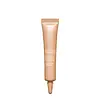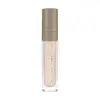What's inside
What's inside
 Key Ingredients
Key Ingredients

 Benefits
Benefits

 Concerns
Concerns

 Ingredients Side-by-side
Ingredients Side-by-side

Water
Skin ConditioningDimethicone
EmollientCI 77492
Cosmetic ColorantCI 77891
Cosmetic ColorantIsododecane
EmollientButylene Glycol
HumectantPEG-9 Polydimethylsiloxyethyl Dimethicone
EmulsifyingPentylene Glycol
Skin ConditioningCI 77491
Cosmetic ColorantMethyl Trimethicone
Skin ConditioningAcrylates/Dimethicone Copolymer
Skin ConditioningDimethicone/PEG-10/15 Crosspolymer
Sodium Chloride
MaskingCI 77499
Cosmetic ColorantSilica
AbrasiveStearoxymethicone/Dimethicone Copolymer
EmollientAscorbyl Glucoside
AntioxidantAvena Sativa Kernel Extract
AbrasiveGlycerin
HumectantTriethoxycaprylylsilane
Disteardimonium Hectorite
StabilisingSodium Citrate
BufferingEthylhexylglycerin
Skin ConditioningSilica Silylate
EmollientAluminum Hydroxide
EmollientSynthetic Fluorphlogopite
Propylene Carbonate
SolventTocopheryl Acetate
AntioxidantTromethamine
BufferingDisodium EDTA
Escin
TonicChenopodium Quinoa Seed Extract
Skin ConditioningDimethiconol
EmollientDipropylene Glycol
HumectantSodium Benzoate
MaskingCitric Acid
BufferingMarrubium Vulgare Extract
Skin ConditioningPhenethyl Alcohol
MaskingFurcellaria Lumbricalis Extract
Skin ConditioningTocopherol
AntioxidantLapsana Communis Flower/Leaf/Stem Extract
Skin ConditioningMaris Sal
Skin ConditioningWater, Dimethicone, CI 77492, CI 77891, Isododecane, Butylene Glycol, PEG-9 Polydimethylsiloxyethyl Dimethicone, Pentylene Glycol, CI 77491, Methyl Trimethicone, Acrylates/Dimethicone Copolymer, Dimethicone/PEG-10/15 Crosspolymer, Sodium Chloride, CI 77499, Silica, Stearoxymethicone/Dimethicone Copolymer, Ascorbyl Glucoside, Avena Sativa Kernel Extract, Glycerin, Triethoxycaprylylsilane, Disteardimonium Hectorite, Sodium Citrate, Ethylhexylglycerin, Silica Silylate, Aluminum Hydroxide, Synthetic Fluorphlogopite, Propylene Carbonate, Tocopheryl Acetate, Tromethamine, Disodium EDTA, Escin, Chenopodium Quinoa Seed Extract, Dimethiconol, Dipropylene Glycol, Sodium Benzoate, Citric Acid, Marrubium Vulgare Extract, Phenethyl Alcohol, Furcellaria Lumbricalis Extract, Tocopherol, Lapsana Communis Flower/Leaf/Stem Extract, Maris Sal
Water
Skin ConditioningCyclopentasiloxane
EmollientIsododecane
EmollientTalc
AbrasivePropylene Glycol
HumectantHydrogenated Polydecene
EmollientBoron Nitride
AbsorbentSynthetic Fluorphlogopite
Polyglyceryl-4 Isostearate
EmulsifyingCetyl PEG/PPG-10/1 Dimethicone
EmulsifyingHexyl Laurate
EmollientTocopheryl Acetate
AntioxidantMagnesium Sulfate
Glycerin
HumectantAscorbyl Palmitate
AntioxidantTriethoxycaprylylsilane
Phenoxyethanol
PreservativeAlumina
AbrasiveAcrylates Copolymer
Lauryl PEG/PPG-18/18 Methicone
Skin ConditioningMalpighia Glabra Fruit Extract
Skin ConditioningPhragmites Karka Extract
Skin ConditioningPoria Cocos Extract
Skin ConditioningAlcohol
AntimicrobialPPG-2-Deceth-30
EmulsifyingEthylhexylglycerin
Skin Conditioning1,2-Hexanediol
Skin ConditioningIsostearyl Alcohol
EmollientSodium Laureth Sulfate
CleansingBiosaccharide Gum-4
Skin ConditioningSodium Dehydroacetate
PreservativeSodium Citrate
BufferingSodium Benzoate
MaskingCitric Acid
BufferingPotassium Sorbate
PreservativeCI 77891
Cosmetic ColorantCI 77492
Cosmetic ColorantCI 77491
Cosmetic ColorantCI 77499
Cosmetic ColorantWater, Cyclopentasiloxane, Isododecane, Talc, Propylene Glycol, Hydrogenated Polydecene, Boron Nitride, Synthetic Fluorphlogopite, Polyglyceryl-4 Isostearate, Cetyl PEG/PPG-10/1 Dimethicone, Hexyl Laurate, Tocopheryl Acetate, Magnesium Sulfate, Glycerin, Ascorbyl Palmitate, Triethoxycaprylylsilane, Phenoxyethanol, Alumina, Acrylates Copolymer, Lauryl PEG/PPG-18/18 Methicone, Malpighia Glabra Fruit Extract, Phragmites Karka Extract, Poria Cocos Extract, Alcohol, PPG-2-Deceth-30, Ethylhexylglycerin, 1,2-Hexanediol, Isostearyl Alcohol, Sodium Laureth Sulfate, Biosaccharide Gum-4, Sodium Dehydroacetate, Sodium Citrate, Sodium Benzoate, Citric Acid, Potassium Sorbate, CI 77891, CI 77492, CI 77491, CI 77499
Ingredients Explained
These ingredients are found in both products.
Ingredients higher up in an ingredient list are typically present in a larger amount.
Ci 77491 is also hydrated iron III oxide. It's sole purpose is to give a red/pink hue to products.
Iron III oxides are classified as inorganic chemicals for coloring.
Synthetically created Ci 77491 is considered safer than those naturally found. This is because the synthetically created version may contain less impurities. Iron oxides are generally non-toxic and non-allergenic.
Learn more about CI 77491Ci 77492 is also hydrated iron III oxide. It's sole purpose is to give a yellow hue to products.
Iron III oxides are classified as inorganic chemicals for coloring.
Synthetically created Ci 77492 is considered safer than those naturally found. This is because the synthetically created version may contain less impurities. Iron oxides are generally non-toxic and non-allergenic.
Learn more about CI 77492Ci 77499 is also hydrated iron III oxide. It is created from mixing red and black iron oxides. This helps give shades of darkness to a product.
Iron III oxides are classified as inorganic chemicals for coloring.
Ci 77891 is a white pigment from Titanium dioxide. It is naturally found in minerals such as rutile and ilmenite.
It's main function is to add a white color to cosmetics. It can also be mixed with other colors to create different shades.
Ci 77891 is commonly found in sunscreens due to its ability to block UV rays.
Learn more about CI 77891Citric Acid is an alpha hydroxy acid (AHA) naturally found in citrus fruits like oranges, lemons, and limes.
Like other AHAs, citric acid can exfoliate skin by breaking down the bonds that hold dead skin cells together. This helps reveal smoother and brighter skin underneath.
However, this exfoliating effect only happens at high concentrations (20%) which can be hard to find in cosmetic products.
Due to this, citric acid is usually included in small amounts as a pH adjuster. This helps keep products slightly more acidic and compatible with skin's natural pH.
In skincare formulas, citric acid can:
While it can provide some skin benefits, research shows lactic acid and glycolic acid are generally more effective and less irritating exfoliants.
Most citric acid used in skincare today is made by fermenting sugars (usually from molasses). This synthetic version is identical to the natural citrus form but easier to stabilize and use in formulations.
Read more about some other popular AHA's here:
Learn more about Citric AcidEthylhexylglycerin (we can't pronounce this either) is commonly used as a preservative and skin softener. It is derived from glyceryl.
You might see Ethylhexylglycerin often paired with other preservatives such as phenoxyethanol. Ethylhexylglycerin has been found to increase the effectiveness of these other preservatives.
Glycerin is already naturally found in your skin. It helps moisturize and protect your skin.
A study from 2016 found glycerin to be more effective as a humectant than AHAs and hyaluronic acid.
As a humectant, it helps the skin stay hydrated by pulling moisture to your skin. The low molecular weight of glycerin allows it to pull moisture into the deeper layers of your skin.
Hydrated skin improves your skin barrier; Your skin barrier helps protect against irritants and bacteria.
Glycerin has also been found to have antimicrobial and antiviral properties. Due to these properties, glycerin is often used in wound and burn treatments.
In cosmetics, glycerin is usually derived from plants such as soybean or palm. However, it can also be sourced from animals, such as tallow or animal fat.
This ingredient is organic, colorless, odorless, and non-toxic.
Glycerin is the name for this ingredient in American English. British English uses Glycerol/Glycerine.
Learn more about GlycerinIsododecane is a fragrance, emollient, and solvent.
As an emollient, it helps your skin stay soft and hydrated. Emollients help trap moisture into your skin.
Isododecane's role as a solvent makes it a great texture enhancer. It spreads smoothly on skin and does not leave a sticky feeling behind. Isododecane also helps prevent color transfer in makeup products.
Isododecane is not absorbed into skin.
Learn more about IsododecaneSodium Benzoate is a preservative. It's used in both cosmetic and food products to inhibit the growth of mold and bacteria. It is typically produced synthetically.
Both the US FDA and EU Health Committee have approved the use of sodium benzoate. In the US, levels of 0.1% (of the total product) are allowed.
Sodium benzoate works as a preservative by inhibiting the growth of bacteria inside of cells. It prevents the cell from fermenting a type of sugar using an enzyme called phosphofructokinase.
It is the salt of benzoic acid. Foods containing sodium benzoate include soda, salad dressings, condiments, fruit juices, wines, and snack foods.
Studies for using ascorbic acid and sodium benzoate in cosmetics are lacking, especially in skincare routines with multiple steps.
We always recommend speaking with a professional, such as a dermatologist, if you have any concerns.
Learn more about Sodium BenzoateSodium Citrate is the sodium salts of citric acid. In skincare, it is used to alter pH levels and acts as a preservative.
Its main functions are to maintain the pH of a product and neutralize metal ions.
The acidity of our skin is maintained by our glands and skin biome; normal pH level of skin is slightly acidic (~4.75-5.5).
Being slightly acidic allows our skin to create an "acid mantle". This acid mantle is a thin barrier that protects our skin from bacteria and contaminants.
Learn more about Sodium CitrateSynthetic Fluorphlogopite is the synthethic version of mica. It consists of fluorine, aluminum and silicate.
Synthetic Fluorphlogopite is used to add volume to products.
It is considered non-irritating on the skin.
Learn more about Synthetic FluorphlogopiteTocopheryl Acetate is AKA Vitamin E. It is an antioxidant and protects your skin from free radicals. Free radicals damage the skin by breaking down collagen.
One study found using Tocopheryl Acetate with Vitamin C decreased the number of sunburned cells.
Tocopheryl Acetate is commonly found in both skincare and dietary supplements.
Learn more about Tocopheryl AcetateTriethoxycaprylylsilane is a silicone used to bind and stabilize ingredients.
As an emulsifier, it helps prevent ingredients from separating. This can help elongate the shelf life of products.
Triethoxycaprylylsilane is often used to coat mineral sunscreens ingredients to help give a better feel. It also helps reduce oxidative stress in sunscreens.
Learn more about TriethoxycaprylylsilaneWater. It's the most common cosmetic ingredient of all. You'll usually see it at the top of ingredient lists, meaning that it makes up the largest part of the product.
So why is it so popular? Water most often acts as a solvent - this means that it helps dissolve other ingredients into the formulation.
You'll also recognize water as that liquid we all need to stay alive. If you see this, drink a glass of water. Stay hydrated!
Learn more about Water